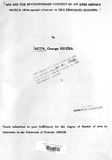| dc.description.abstract | This thesis is an analysis of the art and the Revolutionary content of Ayi Kwei
Armah's novels with a special focus on Two Thousand Seasons. It looks at the influences
that have shaped the man's ideas as well as his artistic intuition. His stay in the United
States of America and his experiences while living in the Socialist Republic of Tanzania are
found to be instructive. The nature and form of his art appear to express his sympathies
with the influential view of the Martiniquan psychiatrist, the late Frantz Fanon. These
views inspire a veritable amount of radicalism in art and are pertinent to our analysis of
the content of Armah's five published novels. They also partly shape our theoretical
framework, namely the school of criticism in which the works themselves are the basis of
any judgments.
The concept of revolutionary content is seen as having to do with the kind of
change that ensures fairness and justice in a society. It is the manner in which Armah's
artistic strategjes (taken.generally as the shape) depart from familiar conventions and the
manner in which the content yearns for positive change, that the study finds revolutionary.
This revolutionary content is traced from the first novel published in 1968 to the
last, published in 1978. The unique characterization in The Healers, the use of peculiar
images, and the use of peculiar language are definitive of the artistic intuition. The
analysis of Two Thousand Seasons shows that the novel offers the best illustration of a
revolutionary content. This content is given an equal artistic form to convey it, namely
the epic narrative mode with all its powerful qualities. This is subtly treated by the author
as to make it an instrument of criticism and not praise as in the traditional context. The
content of Two Thousand Seasons tries to approximate life as it is lived by people engaged
in a struggle for justice and freedom. In the unique fusion of form and content in the
action-oriented novel, Two Thousand Seasons outmatches The Healers and becomes the
apex of the writer's creative talent.
It is our conclusion in this study that writers with a revolutionary message do
employ unique artistic strategies to put it across. This study is not a final statement on
a writer who espouses so much artistic variety. The specific meaning or meanings of
Armah's imagery and symbolism is one area that needs exclusive and detailed attention.
The other is his manifestly changed attitude towards women between the first three novels
and the latter two. In these, it is hoped that we have made a contribution to the analysis
and appreciation of the works of an important contemporary African writer. | en |

